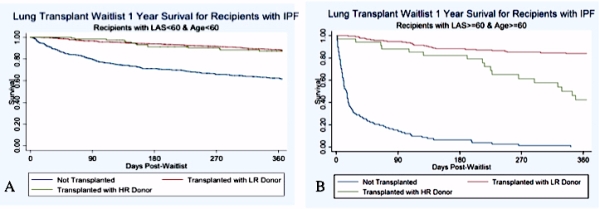The Impact of High-Risk Lung Donors on the Survival of Lung Recipients With Interstitial Pulmonary Fibrosis
1Cardiac Surgery, University of Maryland School of Medicine, Baltimore, MD
2Medicine, University of Maryland School of Medicine, Baltimore, MD.
Meeting: 2015 American Transplant Congress
Abstract number: 120
Keywords: Donors, Lung transplantation, marginal, Survival
Session Information
Session Name: Concurrent Session: Lung: Optimizing Outcomes
Session Type: Concurrent Session
Date: Sunday, May 3, 2015
Session Time: 4:00pm-5:30pm
 Presentation Time: 4:24pm-4:36pm
Presentation Time: 4:24pm-4:36pm
Location: Room 115-C
Matching donors and recipients is largely based on experience. With the implementation of the LAS, IPF candidates have the highest provability of being transplanted after listing. As centers are extending their donor acceptance criteria we investigated if the use of high-risk donors (HR) affects survival of IPF lung transplant candidates.
Methods: we identified IPF candidates listed for lung transplantation from 2005-13 in the UNOS dataset. Using Cox regression we stratified donor and recipient risk for increased mortality. A HR donor was defined as having one of the following: PaO2 ≤ 300 and history of smoking ≥ 20 pack-year, PaO2 ≤ 300 and age ≥ 60, or history of diabetes. A high-risk IPF had an LAS and age ≥ 60. Donors and IPF candidates that did not match these criteria were considered low-risk. One-year survival from the time of listing was the primary outcome. We also investigated one-year survival after transplant.
Results: Of a total of 4,164 IPF patients on the UNOS waitlist, 2,998 ( 72 %) were transplanted within one year of being listed, and 349 received lungs from HR donors. One-year post listing survival in IPFs with an LAS and age ≤ 60 was not compromised by using HR or LR donors (0.87 vs 0.88; p=0.80)  , and was significantly higher than if not transplated (0.616; p=0.01). In IPFs with an LAS and age ≥ 60 one-year post listing survival was significantly lower when using HR vs LR donors (0.42 vs. 0.84; p=0.00). IPFs with an LAS and age ≥ 60 that were not transplanted within one-year of listing had a 0% survival. One-year post-transplant survival was only significantly lower for IPFs with a LAS and age ≥ 60 receiving lungs from HR vs LR donors (0.43 vs. 0.83; p=0.00).
, and was significantly higher than if not transplated (0.616; p=0.01). In IPFs with an LAS and age ≥ 60 one-year post listing survival was significantly lower when using HR vs LR donors (0.42 vs. 0.84; p=0.00). IPFs with an LAS and age ≥ 60 that were not transplanted within one-year of listing had a 0% survival. One-year post-transplant survival was only significantly lower for IPFs with a LAS and age ≥ 60 receiving lungs from HR vs LR donors (0.43 vs. 0.83; p=0.00).
Conclusion: the use of HR donors was only associated with decreased one-year survival in IPF candidates with an LAS and age ≥ 60. Even in this population lung transplantation offered a significantly higher survival.
To cite this abstract in AMA style:
Sanchez P, Mulligan M, Evans C, Timofte I, Kim J, Rajagopal K, Iacono A, Gammie J, III RPierson, Griffith B, Pham S. The Impact of High-Risk Lung Donors on the Survival of Lung Recipients With Interstitial Pulmonary Fibrosis [abstract]. Am J Transplant. 2015; 15 (suppl 3). https://atcmeetingabstracts.com/abstract/the-impact-of-high-risk-lung-donors-on-the-survival-of-lung-recipients-with-interstitial-pulmonary-fibrosis/. Accessed December 17, 2025.« Back to 2015 American Transplant Congress
